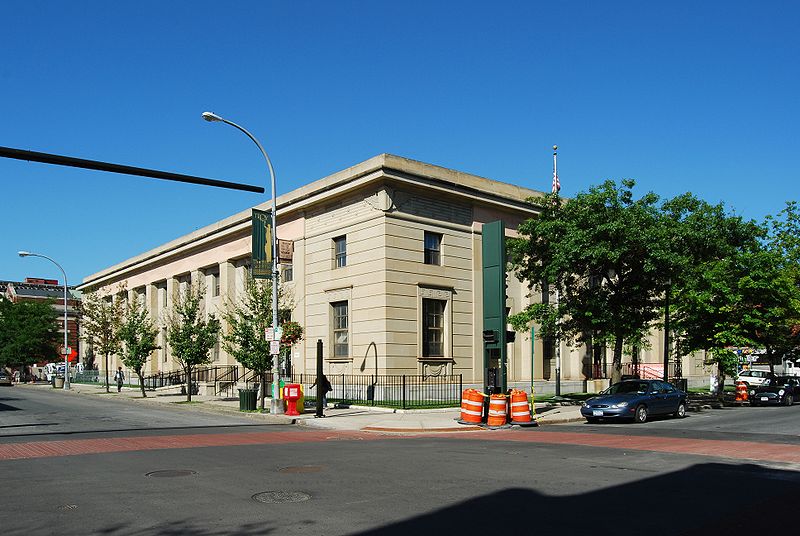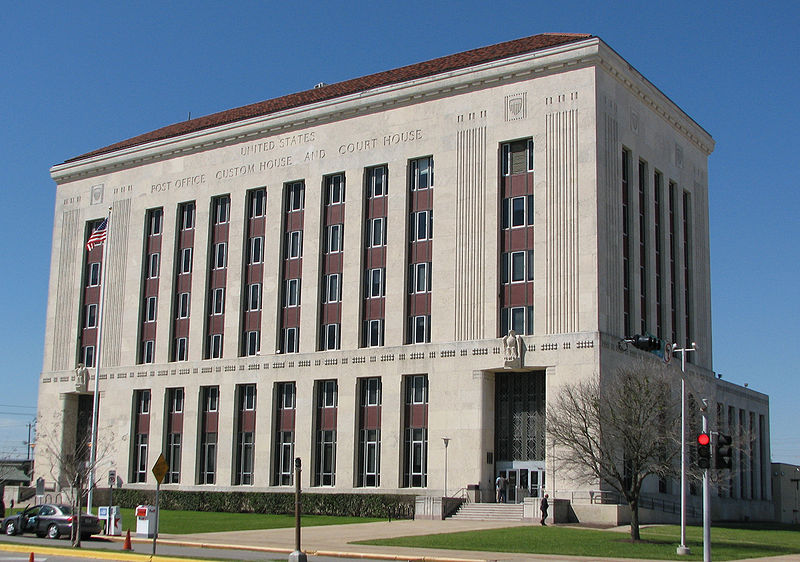[Edit 09/07/11 @ 5:03PM EST] It has been mentioned in the comments, and elsewhere, that while the Postal Service is facing a solvency problem, that problem is the direct result of Republican-led legislation that burdens them with excessive overhead. I completely agree with this sentiment. The 109th Congress, passed the “The Postal Accountability and Enhancement Act” in 2006, which you can read in full here. The law requires that the USPS pre-fund 75 years-worth of pensions, and prohibits them from selling goods that are not directly used for sending letters and packages. I suggest you read more about this legislation here and here. I encourage all of you do to your own research and post what you find in the comments.]
- Photo Credit: Wikipedia – The Galveston Federal Building, built in 1937, is a multi-purpose building with many different government agencies. Don’t bleed the Post Office dry, make it a 21st Century Civic Center
Reading the news lately, makes it seem as though the Post Office is giving its final economic death rattle. Post Master General Patrick Donahoe spoke at a Senate hearing yesterday, and according to the Christian Science Monitor:
Donahoe reiterated a list of cost-cutting measures he has been proposing in recent months to erase the agency’s deficit, which could reach up to $10 billion this fiscal year. They include eliminating Saturday mail delivery, closing as many as 3,700 postal locations, and laying off 120,000 workers – nearly one-fifth of the agency’s work force. (This doesn’t include another 100,000 jobs lost to attrition that the agency does not plan to replace, for a total of 220,000 lost positions.)
These are disgraceful solutions to what could be considered an exciting opportunity to innovate. The Internet is being blamed for many of the Post Office’s problems, and it is safe to say that email has put a significant dent in their revenues. But revenues are only half the story. Expenditures are equally important. Duany, Plater-Zyberk, and Speck in their book Suburban Nation relay a conversation with a former (unnamed) Postmaster General who explained that most of our postage goes to the gas for the trucks and vans that carry mail to the suburban fringes of municipalities. Indeed, the USPS has the largest civilian truck fleet in the world. In an era of austerity, we need to look for ways to reduce spending while maintaining affordable services. I just think we need to spend less money on machines, and more on people. The internet can help us do this.
This is not completely my idea. Planning students have been writing masters theses on these sorts of projects for at least a decade. But they have not been noticed because it requires a certain change in how we do business. The first (and most drastic) step is to suspend door-to-door mail service. First class mail can be scanned and delivered to a registered private email address. Packages are to be delivered to Neighborhood Package Centers or NPCs and kept in individual lockers. Residents receive notification via cell phone or email that a package has arrived and they are to pick them up in a specified locker with a generated key code.
The Neighborhood Package Center could become the centerpiece of Augmented American Civic Life. During my short stint as an intern in the Sarasota County planning department under Peter Katz I wrote a white paper on the subject. By suspending door-to-door services, you generate considerable traffic (and buying power) in specific locations where the NPC is built. These locations become the areas of economic revitalization that we need the most. NPCs will work best in dense walkable neighborhoods which, are also the neighborhoods that need the most help. Rural and suburban neighborhoods can take back vacant Wal-Mart storefronts and use them for the civic good.

Neighborhoods will harness the economic power of Amazon and eBay and capture them in the very brick and mortar of their downtowns. Businesses that cannot do business on the internet (think coffee shops, restaurants, gyms, hair salons, etc.) will take advantage of the increased traffic the NPC provides and setup shop nearby. This is also an opportunity for new business models.With refrigerated lockers, residents can order groceries on the internet and pick them up within several hours. Entire virtual farmers markets can happen, and local retailers can drive the short distance to place their goods in the centralized NPC.
Letter carriers could be the employees of new 24-hour federal internet-enabled civic centers. The NPC has the potential to augment our downtowns and build necessary social capital that communities need. It also means contracting with companies to offer every citizen some kind of cell phone access to tell them when they have a new package. Let us take this opportunity to eliminate the digital divide as well. We can reinvigorate our downtowns by improving our digital infrastructure. When neighborhoods come together to pool their resource, we create thriving local economies that are the basis for a strong union. It is clear that the current incarnation of the Postal Service is an unsustainable business model. Let us see this as an opportunity to do something truly innovative, and not put more people out of work.


Comments 4
mgg — September 7, 2011
Just accepting the notion that the post office is dying is buying into the Republican narrative.
Since the Postal Accountability and Enhancement Act of 2006, they've been required to take on the unique burden of prefunding 75 years of healthcare costs over a 10 year span, forcing them to pay $5.5 billion a year into a fund they can't touch. They would've been profitable these last years if not for this massive cost, and now their healthcare account is overfunded by tens of billions of dollars while they can't make payments to existing pensioners.
The current incarnation of the post office IS profitable, or, more specifically, WAS profitable until a republican congress and republican president purposefully hamstrung it. Now that they've made the second largest employer in the country - where half the employees are unionized - unprofitable, they get to cry about inefficiencies and corrupt union workers and a culture of entitlement, and demand we slash benefits and or privatize the whole deal.
Joshua Comer — September 7, 2011
I like seeing some thought on how old and new systems of communication can integrate. While reading your piece I had some more esoteric cultural concerns about how your scanning solution would require uniform changes in sentimentality and legality, perhaps for good or ill, but I'll remain with the practical questions I have for now.
First, Amazon in my experience has exclusively used UPS and FedEx. It seems to me that transitioning the USPS out of package delivery into a P.O. box business would just drive the traffic further in the direction of the massive suburban sorting centers owned by those companies rather than fix those resources at a local post office.
I don't see how this solution preserves government jobs. Unless you want as many former mail delivery workers milling around the post office as prospective patrons of this new cultural center, there seems to me to be no demonstrable purpose for more employees to stay on than the skeleton counter staff.
I don't understand where these centers would be - can you show me a common example? Abandoned big-box stores are not often in walkable areas, but you suggest that rural and suburban communities could reclaim them for these purposes (if I am reading that right). If planning along these lines is concerned with accessibility, wouldn't most of these new postal centers be in communities that are already the respective area farm market and independent business hubs - the expensive boutique town centers?
Whitney — September 7, 2011
I love it, I think this would work great for my neighborhood in Seattle where everyone is always walking around anyway, but I worry about how this would effect people in rural areas like the part of north Florida I went to high school in. There are a lot of people who still don't use the internet or don't even have internet access, how are they going to get things like their bills on time? It's not just Amazon groceries that are being delivered by mail, and in fact the packages are probably the least important part of what the USPS does (since UPS and FedEx pretty much got packages on lock down).
Could Email Save The Postal Service? | Search Engine Optimization by Prager Microsystems — February 21, 2012
[...] Masters students have been writing theses on this idea for years. In an article by David Banks, he suggests a new method: Since most of the USPS revenue goes to gas for its enormous fleet of trucks, they could eliminate door-to-door delivery service to cut down on gas costs and instead, set up ‘Neighborhood Package Centers’. A package would arrive at the NPCs instead of being delivered and the USPS would notify the recipient of its arrival via email. The recipient would then go to their local NPC to pick up the package. The NPCs would not only save the USPS, but also generate traffic in the area and boost economy. (To read more, click here.) [...]